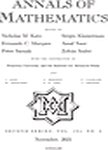-
作者:Ikeda, T
-
作者:Bishop, CJ
摘要:We show that every deformation of a divergence-type Fuchsian group has a limit set which is either a circle or has dimension strictly larger than 1. This is known to be false for all convergence-type groups, and hence solves Bowen's problem in the general case. The proof uses a theorem of Dennis Sullivans about convex hulls in hyperbolic 3-space and we give a new, simpler proof of this result as well.
-
作者:Johansson, K
摘要:We consider discrete orthogonal polynomial ensembles which are discrete analogues of the orthogonal polynomial ensembles in random matrix theory. These ensembles occur in certain problems in combinatorial probability and can be thought of as probability measures on partitions. The Meixner ensemble is related to a two-dimensional directed growth model, and the Charlier ensemble is related to the lengths of weakly increasing subsequences in random words. The Krawtchouk ensemble occurs in connect...
-
作者:Mohnke, K
摘要:We prove (a weak version of) Arnold's Chord Conjecture in [2] using Gromov's classical idea in [9] to produce holomorphic disks with boundary on a Lagrangian submanifold.
-
作者:Frenkel, E; Gaitsgory, D; Vilonen, K
-
作者:Granville, A; Soundararajan, K
-
作者:Cap, A; Slovák, J; Soucek, V
-
作者:Agol, I; Long, DD; Reid, AW
摘要:Let d be a square free positive integer and O-d the ring of integers in Q(root -d). The main result of this paper is that the groups PSL(2,O-d) are subgroup separable on geometrically finite subgroups.
-
作者:Collin, P; Hauswirth, L; Rosenberg, H
-
作者:Liebeck, MW; Shalev, A
摘要:Let G be a finite simple group and let S be a normal subset of G. We determine the diameter of the Cayley graph F(G, S) associated with G and S, up to a multiplicative constant. Many applications follow. For example. we deduce that there is a constant c such that every element of G is a product of c involutions (and we generalize this to elements of arbitrary order). We also show that for any word w = w (x(1),. . .,x(d)). there is a constant c = c(w) such that for any simple group G on which w...
